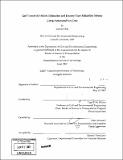| dc.contributor.advisor | Nigel H.M. Wilson. | en_US |
| dc.contributor.author | Chan, Joanne, S.M. Massachusetts Institute of Technology | en_US |
| dc.contributor.other | Massachusetts Institute of Technology. Dept. of Civil and Environmental Engineering. | en_US |
| dc.date.accessioned | 2007-09-28T13:18:27Z | |
| dc.date.available | 2007-09-28T13:18:27Z | |
| dc.date.copyright | 2007 | en_US |
| dc.date.issued | 2007 | en_US |
| dc.identifier.uri | http://hdl.handle.net/1721.1/38955 | |
| dc.description | Thesis (S.M.)--Massachusetts Institute of Technology, Dept. of Civil and Environmental Engineering, 2007. | en_US |
| dc.description | Includes bibliographical references (p. 190-191). | en_US |
| dc.description.abstract | The availability of automatic fare collection (AFC) data greatly enhances a transit planner's ability to understand and characterize passenger travel demands which have traditionally been estimated by manual surveys handed out to passengers at stations or on board vehicles. The AFC data also presents an unprecedentedly consistent source of information on passenger travel times in those transit networks which have both entry and exit fare gates. By taking the difference between entry and exit times, AFC transactions can be used to capture the bulk of a passenger's time spent in the system including walking between gates and platforms, platform wait, in-train time, as well as interchange time for multi-vehicle trips. This research aims at demonstrating the potential value of AFC data in rail transit operations and planning. The applications developed in this thesis provide rail transit operators an easy-to-update management tool that evaluates several dimensions of rail service and demand at near real-time. While the concepts of the applications can be adapted to other transit systems, the detailed configurations and unique characteristics of each transit system require the methodologies to be tailored to solve its needs. | en_US |
| dc.description.abstract | (cont.) The focus of this research is the London Underground network which adopted the automatic fare collection system, known as the "Oyster Card", in 2003. The Oyster card is now used as the main form of public transport fare payment in all public transport modes within the Greater London area. The two applications developed for the London Underground using Oyster data are (1) estimation of an origin-destination flow matrix that reflects current demand and (2) rail service reliability metrics that capture both excess journey time and variation in journey times at the origin-destination, line segment or line levels. The Oyster dataset captures travel on more than three times the number of OD pairs in one 4-week AM peak period compared to those OD pairs evident in the RODS database - 57,407 vs. 17,421. The resulting Oyster-based OD matrix shows very similar travel patterns as the RODS matrix at the network and zonal levels. Station level differences are significant at a number of central stations with respect to interchanges. At the OD level, the differences are the greatest and a significant number of OD pairs in the RODS matrix seem to be erroneous or outdated. The proposed Excess Journey Time Metric and Journey Time Reliability Metric utilize large continuous streams of Oyster journey time data to support analyses during short time periods. | en_US |
| dc.description.abstract | (cont.) The comparison of the Excess Journey Time Metric and the official Underground Journey Time Metric show significant differences in line level results in terms of both number of excess minutes and relative performance across lines. The differences are mainly due to differences in scheduled journey times and OD demand weightings used in the two methodologies. Considerable differences in excess journey time and reliability results exist between directions on the same line due to the large imbalance of directional demand in the AM peak. | en_US |
| dc.description.statementofresponsibility | by Joanne Chan. | en_US |
| dc.format.extent | 191 p. | en_US |
| dc.language.iso | eng | en_US |
| dc.publisher | Massachusetts Institute of Technology | en_US |
| dc.rights | M.I.T. theses are protected by copyright. They may be viewed from this source for any purpose, but reproduction or distribution in any format is prohibited without written permission. See provided URL for inquiries about permission. | en_US |
| dc.rights.uri | http://dspace.mit.edu/handle/1721.1/7582 | |
| dc.subject | Civil and Environmental Engineering. | en_US |
| dc.title | Rail transit OD matrix estimation and journey time reliability metrics using automated fare data | en_US |
| dc.type | Thesis | en_US |
| dc.description.degree | S.M. | en_US |
| dc.contributor.department | Massachusetts Institute of Technology. Department of Civil and Environmental Engineering | |
| dc.identifier.oclc | 166274490 | en_US |
